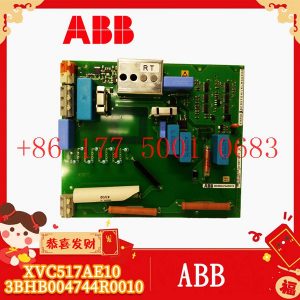Description
hardware flow control. It is an ideal choice in the field of industrial automation.
Why is the industrial Internet inseparable from industrial control?
ABB Global CEO Ulrich Spiesshofer recently accepted an exclusive interview with a reporter from Caijing in New York. He believes that the global manufacturing industry is
undergoing drastic changes. The era of labor arbitrage is over. Labor costs are no longer the focus of competition. The future of manufacturing lies in In factories that are smaller,
closer to consumers, and more agile. Artificial intelligence ( AI ) is the most important technology shaping the future of manufacturing. Currently, AI technology is mainly used in the
consumer field, but its large-scale application in the industrial field and among enterprises is more critical.
Digital transformation has been a keyword for global manufacturing giants in the past two years, and the industrial Internet is the implementation form of digital transformation.
General Electric (GE), Siemens and ABB are all leaders in this regard . Spiesshofer believes that GE”s industrial Internet only collects data and analyzes but cannot control it.
As the world”s two largest industrial automation suppliers, ABB and Siemens have the ability to control equipment, which is a significant difference from GE.
ABB is headquartered in Zurich, Switzerland. Its history can be traced back to the 1880s. It started from the original electrical manufacturing business and has developed into an international manufacturing
giant including electrical products, robotics and motion control, industrial automation and power grid. In 2017, ABB”s revenue was US$34.3 billion, ranking 341st among the
Fortune 500 companies. Spiesshofer has served as CEO for nearly five years since taking office in September 2013.
Below are the details of the interview.
The era of labor arbitrage is over
Caijing: Is 2018 a good year for the manufacturing industry?
Spiesshofer: From a global perspective, GDP is growing and consumption is also growing. Overall positive.
Caijing: What crucial changes are taking place in the manufacturing industry?
Spiesshofer: The jobs of the future will be different from the jobs of the past. In the Middle Ages, craftsmen moved between villages, taking their tools with them to work where
there was demand; later we invented factories, integrated supply and demand, and invented logistics; later people realized that there was labor arbitrage (Labor Arbitrage, Refers to
the existence of moving industries that have lost technological advantages and technical barriers to areas with low labor prices to increase profits by reducing labor costs), so we place
factories in emerging countries to benefit from labor arbitrage.
Now, with the development of modern automation and robotics, we can break this picture and bring value addition closer to demand. I think the future of manufacturing is
in factories that are smaller, closer to consumers, and more agile. I believe that the global logistics chain will also be reduced in the future because we will produce products closer to consumers.
The era of labor arbitrage shaping the global manufacturing landscape will be over because we can offset this arbitrage.
Recently we opened a new factory in Germany. Due to the adoption of intelligent automation technology, its unit cost is exactly the same as that of the best factories in
China. So I think the local market will be repositioned in the future, and the positioning of competitiveness will also change from just considering costs to focusing more on technology and value.
Caijing: Many people are complaining that automation has caused people to lose their jobs, and artificial intelligence technology has made the complaints louder
. But these new technologies are also creating new jobs. How do you see the relationship between the two?
Spiesshofer: In 1990, one-third of the world”s population lived below the extreme poverty line. Today, only 8% rely on technology. In fact, countries with the
highest robot densities, such as Germany, South Korea, Singapore, and Japan, also have the lowest unemployment rates. Robots combined with educated people can create prosperity, produce more
affordable goods, and lead to economic growth. Government, education and business need to work together to keep up with the changing world.
Clearly, millions of jobs are disappearing, but millions of new ones are being created. Taking our own business as an example, we used to have many
employees doing metal casting and forging work, but now these tasks are automated. But now we have more employees working in the service industry, developing apps, and working with customers.
So I think we should not be afraid of change, but should lead our employees to manage change and promote change. If we succeed, global employment will eventually grow.
https://www.xmamazon.com
https://www.xmamazon.com
https://www.plcdcs.com/
www.module-plc.com/
https://www.ymgk.com
NF93A-2 HESG440280R2 ABB | Power electronic module
NDCU-12C NDCU-12CK ABB | Analog input subroutine
MSR04X1 ABB | DCS power module
MC91 HESG440588R4 HESG112714/B ABB | Pulse amplifier plate
3BHL000986P7000 ABB | Processor end module
SG13433241070 ABB | Modular redundant controller
GJR5252300R3101 ABB | Communication control panel
3BHE046836R0101 ABB | Controller system in stock
3BHE022294R0103 ABB | Central processing unit
3BHE022294R0103 ABB | Processor unit
PPD113-B03-23-111615 ABB | Central processing unit
PP835 3BSE042234R1 | Touch screen
ABB PP825A 3BSE042240R3 | Touch screen
PP815A 3BSE042239R2 ABB | Man-machine interface
PP836 3BSE043449R501 ABB | Man-machine interface
PP820 3BSE042243R1 ABB | Function key panel
TRICONEX 3805E | Signal input/output module
PP826 3BSE042244R1 ABB | Function key panel
SCHNEIDER TSXCUSBMBP | PLC control system
RELIANCE ELECTRIC WR-D4008 | Digital input module
RELIANCE ELECTRIC S-D4043 | Distributed control system
RELIANCE ELECTRIC S-D4041 | Programmable control system
RELIANCE ELECTRIC S-D4012 | Channel analog input
RELIANCE ELECTRIC S-D4007 | Programmable control system
RELIANCE ELECTRIC S-D4006 | Multifunctional controller
NI SCXI-1520 | strain input module
NI SCXI-1127 | Multiplexer switch module
NI SCXI-1125 | Voltage input module
NI SCXI-1000 | SCXI Chassis NI
LAETUS LLS570-05 | Laser scanner
GE WESDAC D20ME | Digital input module
GE WES5302-150 | I/O communication modules
GE WES5162 | frame
GE WES5302-111 | Distributed control system
GE WES5162-9101 | Frame interface module
GE WES5123-2600 |Analog output module
WES5123-1200 GE | Analog input module
WES5120 5120-1106 GE | Serial communication module
WES5120 5120-1506 GE |Field controller master unit
PRG-MODEM GE |8-channel digital input
WES13-3 GE |Pressure regulating device main control board
DL-1200/RTU GE | Digital input module |New spot
GE D20 MIC 10BASE-T |I/O module|Fresh spot
Framework of GE D20 EME | Fresh spot
GE D20 EME 10BASE-T | I/O unit module |New spot
D20 EME GE | Analog input module | Fresh spot
XV-440-10TVB-1-13-1 EATON | Man-machine interface |New spot
PU512V2 3BUR001401R1 ABB | Digital input card |New spot
1TGE120010R1300 ABB | Digital input card | Fresh spot
REG216 | Robot drive power supply | ABB
216NG63 | Analog input board | ABB
S-D4041 | Analog input module | RELIANCE ELECTRIC
S-D4043 | PLC controller | RELIANCE ELECTRIC
WR-D4008 | Analog input module | RELIANCE ELECTRIC









Reviews
There are no reviews yet.